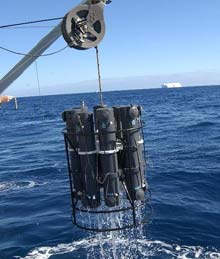Moss Landing Researchers reveal iron as key to climate change

Trace metal rosette recovery aboard R/V Melville <br>Credit: Kenneth Coale-MLML
A remarkable expedition to the waters of Antarctica reveals that iron supply to the Southern Ocean may have controlled Earth’s climate during past ice ages. A multi-institutional group of scientists, led by Dr. Kenneth Coale of Moss Landing Marine Laboratories (MLML) and Dr. Ken Johnson of the Monterey Bay Aquarium Research Institute (MBARI), fertilized two key areas of the Southern Ocean with trace amounts of iron. Their goal was to observe the growth and fate of microscopic marine plants (phytoplankton) under iron-enriched conditions, which are thought to have occurred in the Southern Ocean during past ice ages. They report the results of these important field experiments (known as SOFeX, for Southern Ocean Iron Enrichment Experiments) in the April 16, 2004 issue of Science.
Previous studies have suggested that during the last four ice ages, the Southern Ocean had large phytoplankton populations and received large amounts of iron-rich dust, possibly blown out to sea from expanding desert areas. In order to simulate such ice-age conditions, the SOFeX scientists added iron to surface waters in two square patches, each 15 kilometers on a side, so that concentrations of this micronutrient reached about 50 parts per trillion. This concentration, though low by terrestrial standards, represented a 100-fold increase over ambient conditions, and triggered massive phytoplankton blooms at both locations. These blooms covered thousands of square kilometers, and were visible in satellite images of the area.
Each of these blooms consumed over 30,000 tons of carbon dioxide, an important greenhouse gas. Of particular interest to the scientists was whether this carbon dioxide would be returned to the atmosphere or would sink into deep waters as the phytoplankton died or were consumed by grazers. Observations by Dr. Ken Buesseler of Woods Hole Oceanographic Institution and Dr. Jim Bishop of Lawrence Berkeley National Laboratories (reported separately in the same issue of Science) indicate that much of the carbon sank to hundreds of meters below the surface. When extrapolated over large portions of the Southern Ocean, this finding suggests that iron fertilization could cause billions of tons of carbon to be removed from the atmosphere each year. Removal of this much carbon dioxide from the atmosphere could have helped cool the Earth during ice ages. Similarly, it has been suggested that humans might be able to slow global warming by removing carbon dioxide from the atmosphere through a massive ocean fertilization program.
Unlike previous iron fertilization experiments, SOFeX focused on the two different parts of the Southern Ocean to determine if the iron-induced blooms would be influenced by variations in silicic acid concentrations. Silicic acid is essential to the growth of diatoms, a common type of phytoplankton. The southern part of the Southern Ocean typically has an abundance of silicic acid but the northern part often has very low levels. The results of this experiment indicate that even where silicic acid levels are low, iron fertilization can result in blooms of phytoplankton such as dinoflagellates and prymneseophytes, which do not require silicon for growth yet still consume vast amounts of carbon dioxide. This finding has doubled the area of the Southern Ocean that scientists believe could be important for carbon cycling.
The SOFeX experiment was carried out during January and February of 2002, after a decade of planning and preparation, and was funded by the US National Science Foundation and the US Department of Energy. It involved two US research vessels from Scripps Institution of Oceanography and one US Coast Guard research ice-breaker, as well as about 100 scientists from at least eighteen different research institutions. This important experiment is covered in three research articles in the April 16 issue of Science, and is featured on the magazine’s cover.
Research article citation:
Kenneth H. Coale, et al. Southern ocean iron enrichment experiment: carbon cycling in high-and low-Si waters. Science. Vol. 304 #5669 (April 16, 2004).
Media contacts:
Dr. Kenneth Coale, Moss Landing Marine Laboratories (831) 771-4406; coale@mlml.calstate.edu
Kim Fulton-Bennett, Communications Associate, Monterey Bay Aquarium Research Institute, (831) 775-1835; kfb@mbari.org
Media Contact
More Information:
http://www.mlml.calstate.edu/news/newsdetail.php?id=34All latest news from the category: Earth Sciences
Earth Sciences (also referred to as Geosciences), which deals with basic issues surrounding our planet, plays a vital role in the area of energy and raw materials supply.
Earth Sciences comprises subjects such as geology, geography, geological informatics, paleontology, mineralogy, petrography, crystallography, geophysics, geodesy, glaciology, cartography, photogrammetry, meteorology and seismology, early-warning systems, earthquake research and polar research.
Newest articles

You are What You Eat—Stanford Study Links Fiber to Anti-Cancer Gene Modulation
The Fiber Gap: A Growing Concern in American Diets Fiber is well known to be an important part of a healthy diet, yet less than 10% of Americans eat the minimum recommended…

Trust Your Gut—RNA-Protein Discovery for Better Immunity
HIRI researchers uncover control mechanisms of polysaccharide utilization in Bacteroides thetaiotaomicron. Researchers at the Helmholtz Institute for RNA-based Infection Research (HIRI) and the Julius-Maximilians-Universität (JMU) in Würzburg have identified a…

ASXL1 Mutation: The Hidden Trigger Behind Blood Cancers and Inflammation
Scientists show how a mutated gene harms red and white blood cells. LA JOLLA, CA—Scientists at La Jolla Institute for Immunology (LJI) have discovered how a mutated gene kicks off…



